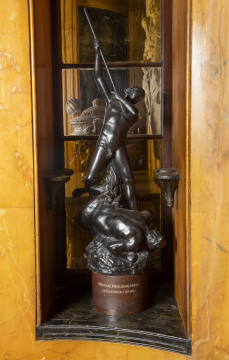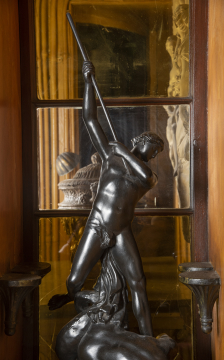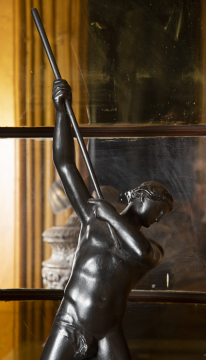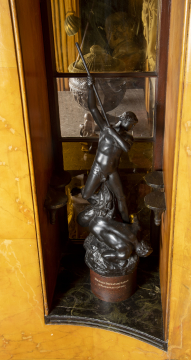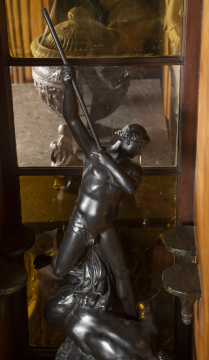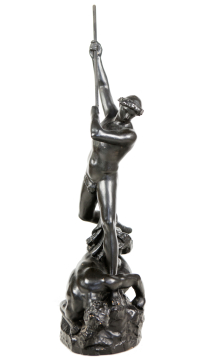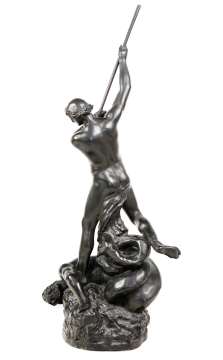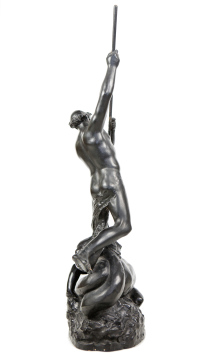Explore Collections


You are here:
CollectionsOnline
/
Model of St Michael overcoming Satan
Browse
SM SC7. ©Sir John Soane's Museum, London. Photo: Art UK
John Flaxman RA (1755 - 1826), sculptor
Model of St Michael overcoming Satan
Plaster painted in imitation of bronze
Height: 87cm
Width: 38cm
Depth: 28cm
Height (plinth): 13cm
Width (plinth): 21cm
Depth (plinth): 17cm
Width: 38cm
Depth: 28cm
Height (plinth): 13cm
Width (plinth): 21cm
Depth (plinth): 17cm
Museum number: SC7
Not on display
Curatorial note
Plaster model(?) for the marble statue of St Michael (the Archangel Michael) overcoming Satan, commissioned from Flaxman by the Earl of Egremont and still on display in the Picture Gallery at his family seat, Petworth House in Sussex. The St Michael is the most of famous of Flaxman’s statues and the subject is derived from John Milton’s Paradise Lost, in which the Archangel Michael commands an army of angels loyal to God against the rebel forces of Satan. Armed with a sword from God's armoury, he defeats Satan in personal combat, wounding his side.
This small-scale version of the sculpture, painted in imitation of bronze, may have been a preparatory model by Flaxman. The finish, however, could indicate that rather than being a working model this was a small-scale copy made for the sculptor to retain in his own collection. Flaxman's full-scale plaster model (11-foot tall) is in the Flaxman Gallery at University College London. The project was completed between 1819 and 1824.
Flaxman based the composition of this sculpture on Raphael’s painting of St. Michael (1518), which is today in the Louvre (the painting has been in France since the early 16th century). He could have seen this work on his trip to Paris in 1802, taking advantage of the opportunity to travel to France afforded by the Peace of Amiens.
The sculptor Richard Westmacott (1775 – 1856), a close friend of both Soane and Flaxman, praised Flaxman's St Michael as ‘the most distinguished proof of Flaxman’s powers of heroic composition.’
This statuette has stood in its current position at the foot of the main staircase, since Soane acquired it in the 1830s.
This small-scale version of the sculpture, painted in imitation of bronze, may have been a preparatory model by Flaxman. The finish, however, could indicate that rather than being a working model this was a small-scale copy made for the sculptor to retain in his own collection. Flaxman's full-scale plaster model (11-foot tall) is in the Flaxman Gallery at University College London. The project was completed between 1819 and 1824.
Flaxman based the composition of this sculpture on Raphael’s painting of St. Michael (1518), which is today in the Louvre (the painting has been in France since the early 16th century). He could have seen this work on his trip to Paris in 1802, taking advantage of the opportunity to travel to France afforded by the Peace of Amiens.
The sculptor Richard Westmacott (1775 – 1856), a close friend of both Soane and Flaxman, praised Flaxman's St Michael as ‘the most distinguished proof of Flaxman’s powers of heroic composition.’
This statuette has stood in its current position at the foot of the main staircase, since Soane acquired it in the 1830s.
Literature
Helen Dorey ‘Soane and Flaxman’ in Flaxman: Master of the Purest Line, Exhibition Catalogue, Sir John Soane’s Museum 2003
Associated items
P438, same subject
Soane collections online is being continually updated. If you wish to find out more or if you have any further information about this object please contact us: worksofart@soane.org.uk
